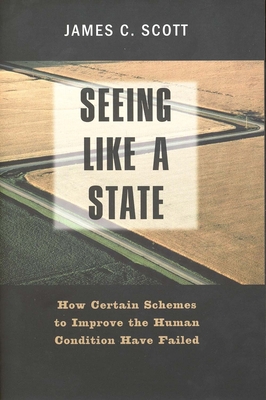Seeing Like a State: How Certain Schemes to Improve the Human Condition Have Failed
James C. Scott

This book was on my mental “to-read” list for a looooong time. I finally got around to reading it because of reading about Scott’s new book, Against the Grain. Unlike many things that are built up over time, it didn’t disappoint me!
The book is written in a rare style that I really enjoy. The other book that comes immediately to mind in the same style is Hirschman’s Exit, Voice and Loyalty. Maybe also Axelrod’s The Evolution of Cooperation. These are books written by academics, premised on taking one relatively simple concept and exploring its application to a variety of real current or historical issues, generally across a range of disciplines. Although the description I just gave sounds in some ways like a “Malcolm Gladwell” style of book, I think the key distinction is that these books are, as I said, written by academics, and prioritize careful exposition of the concept over entertaining presentation. I will add, however, that none of the books I mentioned are written in a stereotypically “academic” style; each would be broadly accessible to a generally intelligent lay reader. I’m sure in part these sorts of books are in short supply because the academic world does not incentivize the writing of such books. But I would love to find more of them!
The actual subject matter of this book was also very interesting to me. Scott explores the large-scale project of making various features of reality “legible” to a large central organization (he generally focuses on the state, but acknowledges that his analysis can apply equally well to, for instance, a large corporation). Primary examples of this include cadastral land surveys and standardization of last names (Scott has an extensive discussion of the Spanish forcing Filipinos to adopt surnames, which I knew about but enjoyed exploring in more depth). He then moves from “classificatory” projects of this type to projects that involve actually altering the organization of society or reality, including “scientific” forestry, monocrop agriculture, collectivization of agriculture in the Soviet Union and in Africa, as well as the construction of planned cities such as Brasilia and Chandigarh. In general, he aims to show the blind spots and failures of these modes of organization, and to connect them to one another. Scott introduces the Greek concept of “metis,” a sort of practical, flexible, and locally oriented knowledge, and argues that large-scale organizational projects vastly underestimate its importance in keeping society running. (Think of a “work-to-rule” strike and why it is effective.) He further argues that, to the extent that large-scale planning is not a complete failure, it is generally because it is supported by a “shadow twin”–for example, planned cities being sustained by unplanned marginal settlements.
Scott is careful not to make the book a mere polemic against state-legibility and large-scale planning. He explicitly recognizes that these types of projects have also led to positive outcomes, such as large-scale immunization and complete eradication of some diseases. His objective seems to be more so to encourage reflectiveness and humility around large-scale planning, and in particular, consideration of the specific types of pitfalls he identifies. He discusses at some length the misguided aesthetic motivations of “high modernism,” and in particular, the conflation of an orderly appearance with actual functional order. I thought this was a really interesting perspective that I wouldn’t have expected to be explored in this type of book.
I would love an updated version of this book that explored further the application of Scott’s concepts to private-sector actions, which seem to me to be at least as important in shaping today’s world as government planning.